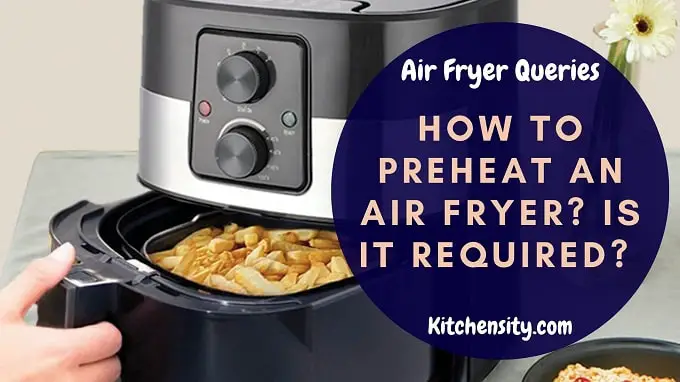Are you a fan of crispy, delicious fried foods but concerned about the limited space in your kitchen?
The rise in popularity of air fryers has offered a convenient solution, allowing you to enjoy your favorite fried treats with less oil and mess.
However, a common dilemma arises: Can you put an air fryer under a cabinet?
In this article, we will explore the factors to consider when deciding whether to place your air fryer under a cabinet.
We will delve into clearance requirements, safety precautions, alternative placement options, and cleaning and maintenance tips to ensure the optimal performance and longevity of your air fryer.
So, if you’re ready to uncover the secrets of placing an air fryer under a cabinet and explore alternative placement options, let’s dive in and find the perfect spot for your beloved kitchen companion.
Let’s ensure that your air fryer finds its place in your culinary adventures while keeping your kitchen organized and efficient.

Table of Contents
- 1 Can You Put an Air Fryer Under a Cabinet?
- 2 Air Fryer Placement Considerations
- 3 Safety Precautions
- 4 Alternatives For Under-Cabinet Placement
- 5 How Much Clearance Does An Air Fryer Need?
- 6 Cleaning And Maintenance
- 7 Conclusion
- 8 FAQs
- 8.1 Can I Put Other Kitchen Appliances Under The Cabinet?
- 8.2 What Happens If I Put An Air Fryer Under A Cabinet?
- 8.3 What Is The Best Surface To Put An Air Fryer On?
- 8.4 Can I Use An Air Fryer On A Countertop?
- 8.5 How Much Clearance Does An Air Fryer Need?
- 8.6 Are There Air Fryers Specifically Designed For Under-Cabinet Use?
Can You Put an Air Fryer Under a Cabinet?
Putting an air fryer under a cabinet is generally not recommended. While it may seem like a convenient option to save counter space, it can pose potential risks. Air fryers generate heat during operation, and placing them under a cabinet can restrict airflow, leading to overheating. This can not only affect the performance of the appliance but also pose a fire hazard.
Also Read – Best Heat-Resistant Mats For Air Fryer
Air Fryer Placement Considerations
When considering where to place your air fryer, it’s essential to take several factors into account.
These factors include the size and weight of the appliance, the clearance required for proper ventilation, and any potential safety concerns.
Factors To Consider
Factors to Consider When Placing Your Air Fryer Under a Cabinet:
- Check The Manufacturer’s Guidelines: Start by reviewing the manufacturer’s guidelines and recommendations for your specific air fryer model. Some models may have built-in safety features that allow for under-cabinet use, while others explicitly advise against it.
- Consider Clearance Requirements: Proper ventilation is essential for the optimal functioning of an air fryer. Take note of the clearance requirements specified by the manufacturer. Ensure there is sufficient space both above and around the air fryer to allow for proper airflow and heat dissipation.
- Assess Cabinet Construction: Evaluate the materials used in the construction of your cabinet. Heat-resistant materials can be less susceptible to damage from the heat generated by the air fryer. However, even with heat-resistant cabinets, it is still advisable to provide ample clearance to minimize potential risks.
By considering these factors, you can make an informed decision about whether placing your air fryer under a cabinet is suitable for your specific model and kitchen setup.
Remember to prioritize safety and adhere to the manufacturer’s guidelines for the best results.
Also Read – Can I Put An Air Fryer On The Countertop?
Safety Precautions
If you do decide to place your air fryer under a cabinet despite the risks, it is essential to follow some safety precautions.
Safety Precautions for Placing an Air Fryer Under a Cabinet:
- Ensure Adequate Ventilation: Before placing your air fryer under a cabinet, make sure the area is well-ventilated and not enclosed. Proper airflow is crucial for dissipating the heat generated by the appliance. This helps prevent overheating and reduces the risk of potential hazards.
- Regularly Inspect For Heat Damage:
- Regularly inspect the cabinet and the surrounding area for any signs of heat damage or discoloration.
- Check for any changes in the cabinet’s appearance, such as warping or discoloration, which could indicate excessive heat exposure.
- If you notice any issues, it is important to discontinue using the air fryer in that location and find an alternative placement.
- Maintain Clearance:
- Even if you have decided to place the air fryer under a cabinet, ensure that you provide ample clearance around the appliance.
- This includes both horizontal and vertical clearance.
- Leave sufficient space on all sides of the air fryer to allow for proper ventilation and heat dissipation.
- Avoid placing other objects or materials too close to the air fryer to minimize any potential risks.
- Monitor During Operation:
- While the air fryer is in use, keep an eye on it and be attentive to any unusual smells, sounds, or behaviors.
- If you notice anything out of the ordinary, such as excessive heat, unusual noises, or malfunctioning controls, immediately turn off and unplug the air fryer.
- Contact the manufacturer or seek professional assistance to address any issues.
- Follow The Manufacturer’s Guidelines:
- Always refer to the manufacturer’s instructions and safety guidelines provided with your specific air fryer model.
- Manufacturers may have specific recommendations or warnings regarding cabinet placement and safety precautions.
- Adhering to these guidelines will help ensure safe operation and prevent potential damage or accidents.
By following these safety precautions, you can minimize the risks associated with placing an air fryer under a cabinet.
However, it is important to note that the safest option is to follow the manufacturer’s recommendations and find an alternative, well-ventilated location for your air fryer to ensure optimal performance and safety.
Also Read: How Do Air Fryers Work Without Oil? Can You Use Oil?
Alternatives For Under-Cabinet Placement
If you have limited counter space and want to keep your air fryer easily accessible, there are alternative placement options to consider.
Rolling Cart Or Air Fryer Stand
- Consider placing your air fryer on a rolling cart or a dedicated air fryer stand.
- These options provide mobility and allow you to easily move the appliance when needed.
- Ensure that the cart or stand provides adequate clearance for proper ventilation and heat dissipation.
- This alternative keeps the air fryer easily accessible while maintaining safety and functionality.
Heat-Resistant Mat Or Silicone Pad
- Another option is to place the air fryer on a heat-resistant mat or a silicone pad.
- These materials act as a protective barrier between the appliance and the surface underneath.
- They can help prevent heat damage to countertops or other surfaces and provide an additional layer of insulation.
- Ensure that the mat or pad is appropriately sized to accommodate the air fryer and allows for proper airflow around the appliance.
Also Read – How To Preheat An Air Fryer?
Wall-Mounted Shelf
- If you prefer to keep your air fryer off the counter, consider installing a wall-mounted shelf in your kitchen.
- This option allows you to place the air fryer at a convenient height while freeing up valuable counter space.
- Ensure that the shelf is sturdy, properly installed, and provides sufficient clearance for ventilation.
Hanging Storage
- Another creative alternative is to utilize hanging storage solutions such as hooks or racks.
- Hang the air fryer from a sturdy hook or place it on a specially designed rack that can securely hold the appliance.
- This option keeps the air fryer easily accessible while minimizing the use of counter space.
Dedicated Cabinet Or Pantry Shelf
- If you have available cabinet or pantry space, consider designating a specific shelf for your air fryer.
- Ensure that the shelf is sturdy and can support the weight of the appliance.
- This option allows you to keep the air fryer out of sight when not in use while still providing a dedicated space for its storage and usage.
When exploring these alternative placement options, always prioritize safety and follow the manufacturer’s guidelines regarding clearance and ventilation.
Choose a solution that best suits your kitchen layout, space availability, and personal preferences while ensuring the optimal performance and safety of your air fryer.
Also Read – Do Air Fryers Use A Lot Of Electricity?
How Much Clearance Does An Air Fryer Need?
When it comes to the clearance requirements for an air fryer, it is important to provide adequate space around the appliance for proper ventilation and heat dissipation.
While the specific clearance needed can vary depending on the manufacturer and model, there are some general guidelines to consider.
- For optimal performance and safety, it is recommended to provide at least 4-6 inches (10-15 cm) of clearance on all sides of the air fryer.
- This includes the back, sides, and top of the appliance.
- This clearance allows for proper airflow, which helps to prevent overheating and ensures that the air fryer functions efficiently.
Having sufficient clearance is crucial because air fryers generate heat during operation.
The hot air needs space to circulate and dissipate, preventing the appliance from overheating and potentially causing damage to nearby objects or surfaces.
Providing ample clearance also reduces the risk of any heat-related accidents, such as scorching or burning nearby materials.
- In addition to the lateral clearance, it is also essential to consider the vertical clearance.
- Ensure that there is enough space above the air fryer to allow for the release of hot air.
- Placing the appliance under low-hanging cabinets or shelves can restrict the airflow and hinder its performance.
- Aim to have at least a few inches of clearance between the top of the air fryer and any overhead obstructions.
While these guidelines provide a starting point, it is crucial to consult the user manual or guidelines provided by the manufacturer for the specific clearance requirements of your air fryer model.
Different models may have variations in clearance recommendations based on their design and specifications.
By providing adequate clearance around the air fryer, you can ensure proper ventilation, maintain the appliance’s performance, and minimize any potential safety risks.
Always prioritize safety and follow the manufacturer’s instructions to enjoy the benefits of air frying without any concerns.
Also Read – Why Are Air Fryers So Popular All Of A Sudden?
Cleaning And Maintenance
Regardless of where you choose to place your air fryer, proper cleaning and maintenance are crucial for its longevity and performance.
Cleaning and Maintenance Tips for Your Air Fryer:
- Follow The Manufacturer’s Instructions:
- Always refer to the manufacturer’s instructions and guidelines for cleaning your specific air fryer model.
- The manufacturer will provide specific recommendations on how to clean and maintain the appliance properly.
- Adhering to these instructions will help ensure safe and effective cleaning.
- Clean After Each Use:
- It is important to clean your air fryer after each use to remove any food residue or oil buildup.
- Allow the appliance to cool down before cleaning.
- Start by unplugging the air fryer and carefully removing the basket or tray.
- Wash the removable parts with warm, soapy water using a non-abrasive sponge or cloth.
- Rinse thoroughly and dry them completely before reassembling the air fryer.
- Wipe The Exterior:
- Regularly wipe the exterior of the air fryer with a damp cloth to remove any grease or stains.
- Avoid using harsh or abrasive cleaning agents that may damage the surface.
- Dry the exterior thoroughly to prevent water from entering the appliance.
- Remove Grease Buildup:
- Over time, grease may accumulate in various parts of the air fryer, including the heating element and the fan.
- Refer to the manufacturer’s instructions on how to clean these areas safely.
- Some air fryers may have removable or accessible components that can be cleaned, while others may require a specific cleaning method.
- Ensure that the appliance is unplugged and cooled down before attempting to clean these internal parts.
- Deep Cleaning As Needed:
- Periodically, it is recommended to perform a deep cleaning of your air fryer.
- This involves a more thorough cleaning of all parts and components.
- Check the manufacturer’s instructions for any specific recommendations on deep cleaning methods or products to use.
- A deep cleaning helps remove stubborn residue and ensures optimal performance.
- Avoid Submerging The Appliance:
- Air fryers are electrical appliances, and it is essential to avoid submerging them in water or placing them in the dishwasher unless specified by the manufacturer.
- Submerging the appliance can cause electrical damage and pose a safety risk.
- Always follow the recommended cleaning methods provided by the manufacturer.
By following these cleaning and maintenance tips, you can keep your air fryer in good condition, prolong its lifespan, and ensure optimal cooking performance.
Regular cleaning removes food residue, prevents the buildup of grease, and maintains the appliance’s functionality.
Prioritize safety, read the manufacturer’s instructions, and enjoy hassle-free air frying with a clean and well-maintained air fryer.
Also Read – How To Clean Baked On Grease From Air Fryer?
Conclusion
The question of whether you can put an air fryer under a cabinet requires careful consideration.
While it may be tempting to save counter space and keep your air fryer conveniently tucked away, it’s essential to prioritize safety and adhere to the manufacturer’s guidelines.
- Placing an air fryer under a cabinet can pose risks such as limited ventilation, heat damage to the cabinet, and potential hazards.
- It’s crucial to assess the clearance requirements, cabinet construction, and ventilation needs of your specific air fryer model.
If you decide against under-cabinet placement, there are alternative options available.
Utilizing a rolling cart, heat-resistant mat, wall-mounted shelf, or dedicated cabinet shelf can provide convenience, accessibility, and proper airflow for your air fryer.
Remember, proper cleaning and maintenance are also vital for the longevity and performance of your air fryer, regardless of its placement.
Regularly follow the manufacturer’s instructions to keep your appliance clean and in optimal condition.
Ultimately, the decision of where to place your air fryer should prioritize safety, functionality, and your kitchen’s specific layout.
By making an informed choice and following the necessary precautions, you can enjoy the benefits of air frying while ensuring a safe and enjoyable cooking experience.
So, whether it finds its spot on the countertop, a dedicated shelf, or another suitable location, let your air fryer take center stage as it creates delicious and healthy meals with ease.
Happy Air Frying!
Also Read – How Do Air Fryers Work Without Oil?
FAQs
-
Can I Put Other Kitchen Appliances Under The Cabinet?
Yes, other kitchen appliances such as toasters, blenders, and coffee makers are generally safe to place under a cabinet.
However, it is essential to consider the heat generated and the ventilation requirements of each appliance to prevent any potential hazards. -
What Happens If I Put An Air Fryer Under A Cabinet?
Putting an air fryer under a cabinet can lead to restricted airflow and overheating. This can not only affect the performance of the appliance but also pose a fire hazard. It is best to avoid this placement to ensure safety.
-
What Is The Best Surface To Put An Air Fryer On?
The best surface to put an air fryer on is a heat-resistant and stable countertop. It is important to choose a surface that can withstand the heat generated by the air fryer during operation.
Heat-resistant materials such as granite, quartz, or stainless steel are ideal choices as they can withstand high temperatures without being damaged. -
Can I Use An Air Fryer On A Countertop?
Yes, using an air fryer on a countertop is the most common and recommended placement option. It allows for proper ventilation and ensures that the appliance operates efficiently and safely.
-
How Much Clearance Does An Air Fryer Need?
The specific clearance requirements can vary depending on the manufacturer and model of the air fryer.
It is crucial to consult the user manual or guidelines provided by the manufacturer to determine the recommended clearance for your specific appliance. -
Are There Air Fryers Specifically Designed For Under-Cabinet Use?
Yes, there are some air fryers available on the market that are specifically designed for under-cabinet use.
These models usually have additional safety features and provide the necessary clearance for safe operation in that placement.
However, it is still important to follow the manufacturer’s instructions and guidelines to ensure proper usage.
Katrina Smith is a seasoned expert with over 25 years of experience in all things related to cooking and the kitchen. As an avid cook and kitchen enthusiast, she is passionate about sharing her knowledge and expertise on cookware, kitchen appliances, kitchen tips, and kitchen staples.
Through her articles and reviews, Katrina aims to inspire and help others improve their cooking skills, experiment with different ingredients, and invest in quality cookware and appliances.






